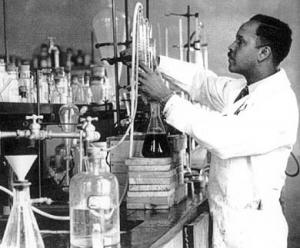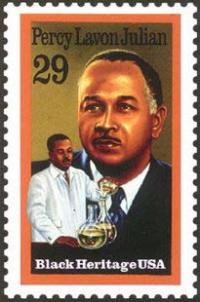
Hidden stories, like hidden jewels, are often the most treasured and precious possessions we could ever hope to find. Such is the case with the story of Percy Lavon Julian, one of America’s preeminent chemists, business leaders, and civil rights pioneers. Like a buried treasure, the story of this brilliant American offers as much value because of what it teaches us about our past, as it inspires us today.
The grandson of slaves, and born on April 11, 1899 in Birmingham, AL, at the height of Jim Crow segregation, Percy Julian was one of six children. His father, a railroad mail clerk, and his mother, a schoolteacher, stressed the importance of education to their children – a value which propelled their children to amazing heights never achieved by previous generations shackled in bondage.
At the turn of the century when advanced education was reserved only for the privileged elite, two of their sons went on to become physicians and three daughters received Masters Degrees. However, Percy was the one to reach the summit of the highest peak.
He attended public schools in Birmingham and Montgomery, AL, through high school. When he graduated in 1916 – on the eve of World War II – Percy learned that DePauw University in Indiana had accepted his college application. When Percy left Alabama to go to college, his entire family, including his 99-year-old Grandmother and Grandfather, both former slaves, accompanied him to the train station. His grandfather’s right hand was two fingers short because they had been cut off for violating the code that forbade slaves from learning to read and write.
Upon arrival at DePauw, the college immediately placed young Percy on academic probation and he had to take his normal college load as well as higher-level high school courses because of the sub-par segregated schools he attended in Alabama. Percy excelled in all areas of his University experience, including his selection as a member of Sigma Xi honorary society and Phi Beta Kappa, and the privilege of being the class valedictorian in 1920.
His success notwithstanding, those in power discouraged the young graduate from seeking admission to graduate school because of his race. Instead, he accepted a teaching position in the Chemistry Department at Fisk University, a prominent Black college in Nashville, TN.
After two years at Fisk, Percy earned the Austin Fellowship in Chemistry at Harvard University. Finally, given an opportunity at graduate level work, Percy resumed his record of academic excellence, finishing number one in his class – he received his Masters Degree in 1923. However, major universities continued to deny him a position, so he taught chemistry first at West Virginia State College for Negroes, and then as an associate professor at Howard University.
In 1929, on the eve of the Great Depression, Percy traveled to Vienna, Austria in pursuit of a doctorate degree. While there, he developed a fascination with the soybean. Focusing on organic chemistry, Percy received his Ph.D. in 1931 and returned to Howard University as the Chairman of the chemistry department. Soon after, he returned to DePauw where he taught organic chemistry and researched the synthesis of a drug used to treat glaucoma. For his outstanding discoveries, and despite the many institutional obstacles, he became internationally renowned.
In 1935, Percy left academia to enter the corporate world where the Glidden Company, a leading manufacturer of paint and varnish, hired him as the chief chemist and the Director of the Soya Product Division. This was yet another ‘first’ among many ‘firsts,’ which ultimately paved the way for future black scientists. Percy and his team of chemists filed more than 100 patents, and turned the soybean inside out. They isolated parts of the bean that served as key ingredients in a vast and varied range of new household and industrial products, including food oils, latex paint, plastics, linoleum, plywood glue, high-protein livestock feed and a fire-retardant foam that saved the lives of countless sailors during World War II.
On Christmas Eve 1935, Percy married Anna Johnson, and continued down his path of greatness with his discovery that the soybean was a perfect starting material for making steroids economically, and therefore, commercially. Seizing on this opportunity, Percy made Glidden – a paint company – the first American firm to successfully manufacture progesterone, a female sex hormone, available in large quantities at reasonable prices. His creativity laid the groundwork for the entire multi-billion dollar field of steroid medicine, whose products would include not only artificial sex hormones like progesterone and testosterone, but also cortisone, critical in alleviating the crippling pain of rheumatoid arthritis, and later the birth control pill. These amazing discoveries helped to prevent miscarriages in pregnant women, and later used to fight cancer and many other ailments for millions of sufferers around the world.
His stellar career, however, did not shield him from the scourge of prejudice. On Thanksgiving Day in 1950, someone firebombed the suburban home he had purchased, and a year later, dynamite exploded beneath his children’s bedroom window.
In 1954, the year of Brown v. Topeka, Percy left the Glidden Company to form his own company, Julian Laboratories, which specialized in producing synthetic cortisone. When he discovered that wild yams in Mexico were even more effective than soybeans, he opened the Laboratorios Julian de Mexico in Mexico City. Julian Laboratories would eventually make him one of the wealthiest black businessmen in America, and allowed him to open doors for other African-American scientists. He hired scores of talented black chemists who could not find employment elsewhere. In addition, by showing that African-Americans could do chemistry at the highest level, he inspired many more students to enter a career field that had previously seemed off limits. In 1961, he sold the company plant in Illinois for $2.3 million – a staggering amount for any American, much less the grandson of slaves, to Smith, Kline, and French, a giant pharmaceutical company.
After years of struggling for respect in his field and his community, Percy finally received recognition as a genius and a pioneer. He received countless awards and honors including the prestigious Spingarn Medal from the NAACP and asked to serve on numerous commissions and advisory boards. His many honors included 19 honorary doctorate degrees. At least nine universities named schools and buildings after him. One was DePauw, which once could not promote him into the professorial ranks.
Recently, PBS produced a two-hour documentary under the NOVA series about Dr. Julian, entitled, “Forgotten Genius,” because this triumphant story had been previously untold.
 A man of genius, devotion, and determination, Percy was also an outsider, fighting to make a place for himself in a profession and country divided by bigotry – a man who eventually found freedom in the laboratory. By the time of his death in 1975 from liver cancer, Percy had risen to the highest levels of scientific and personal achievement. He overcame countless obstacles to become a world-class scientist, a self-made millionaire, and a civil-rights pioneer. He broke the color barrier in American science more than a decade before Jackie Robinson did so in Major League Baseball.
A man of genius, devotion, and determination, Percy was also an outsider, fighting to make a place for himself in a profession and country divided by bigotry – a man who eventually found freedom in the laboratory. By the time of his death in 1975 from liver cancer, Percy had risen to the highest levels of scientific and personal achievement. He overcame countless obstacles to become a world-class scientist, a self-made millionaire, and a civil-rights pioneer. He broke the color barrier in American science more than a decade before Jackie Robinson did so in Major League Baseball.
In 1973, the National Academy of Sciences presented Percy with his crowning honor by making him the second African-American in the history of the organization elected as a member. Even in the shadow of society's prejudice, his drive, intelligence, and mastery of chemistry often prevailed. In a more enlightened era, his colleagues argue, he could have been a Nobel laureate.
Percy liked to illustrate his long arduous climb to Donald Adams’ The Seventh Fold, “My dear friends, who daily climb uncertain hills in the countries of their minds, hills that have to do with the future of our country and of our children, may I humbly submit to you, the only thing that has enabled me to keep doing the creative work, was the constant determination: Take heart! Go farther on!”
That is the precious lesson the world learned when we uncovered the legacy of Percy Lavon Julian, so bright, so precious, so valuable, we can only ask, “How did we overlook him for so long?”
